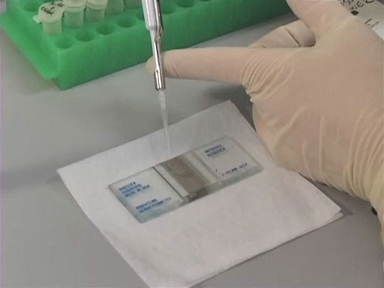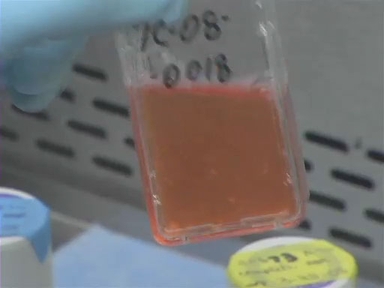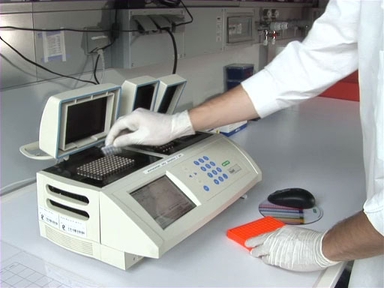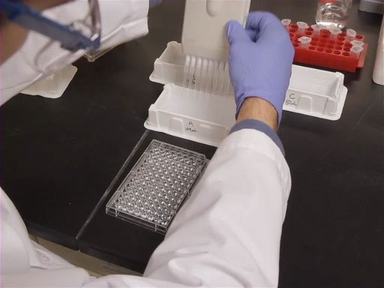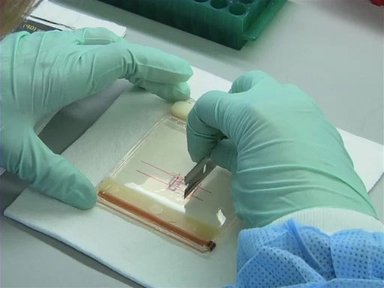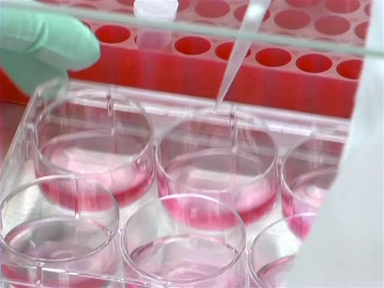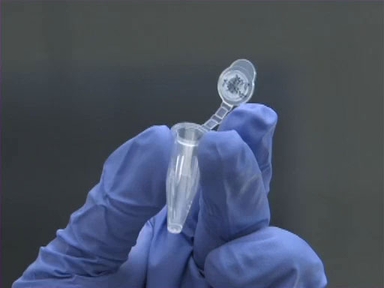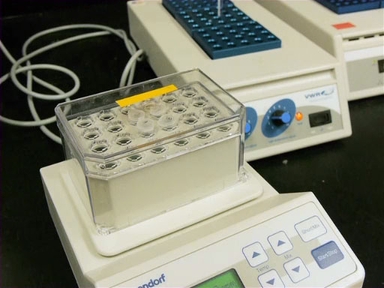Molecular cloning is a set of techniques used to insert recombinant DNA from a prokaryotic or eukaryotic source into a replicating vehicle such as plasmids or viral vectors. Cloning refers to making numerous copies of a DNA fragment of interest, such as a gene. In this video you will learn about the different steps of molecular cloning, how to set up the procedure, and different applications of this technique.
At least two important DNA molecules are required before cloning begins. First, and most importantly, you need the DNA fragment you are going to clone, otherwise known as the insert. It can come from a prokaryote, eukaryote, an extinct organism, or it can be created artificially in the laboratory. By using molecular cloning we can learn more about the function of a particular gene.
Second, you need a vector. A vector is plasmid DNA used as a tool in molecular biology to make more copies of or produce a protein from a certain gene. Plasmids are an example of a vector, and are circular, extra chromosomal, DNA that is replicated by bacteria.
A plasmid typically has a multiple cloning site or MCS, this area contains recognition sites for different restriction endonucleases also known as restriction enzymes. Different inserts can be incorporated into the plasmid by a technique called ligation. The plasmid vector also contains an origin of replication, which allows it to be replicated in bacteria. In addition, the plasmid has an antibiotic gene. If bacteria incorporate the plasmid, it will survive in media that contains the antibiotic. This allows for the selection of bacteria that have been successfully transformed.
The insert and vector are cloned into a host cell organism, the most common used in molecular cloning is E. coli. E. coli grows rapidly, is widely available and has numerous different cloning vectors commercially produced. Eukaryotes, like, yeast can also be used as host organisms for vectors.
The first step of the general molecular cloning procedure is to obtain the desired insert, which can be derived from DNA or mRNA from any cell type. The optimal vector and its host organism are then chosen based they type of insert and what will ultimately be done with it. A polymerase chain reaction, or PCR based method is often used to replicate the insert.
Then by using a series of enzymatic reactions, the insert and digest are joined together and introduced into the host organism for mass replication. Replicated vectors are purified from bacteria, and following restriction digestion, analyzed on a gel. Gel-purified fragments are later sent for sequencing to verify that the inset is the desired DNA fragment.
Let’s have a little more detailed look at how molecular cloning is conducted. Before beginning, you will want to plan out your cloning strategy, prior to making any cloning attempt at the bench. For example, any given plasmid vector, will provide you with a finite number of restriction sites to incorporate the insert via the multiple cloning site. You’ll need to choose restriction sites that are not found in your insert so that you do not cleave it. You might be left with a situation where you are forced to join a blunt end fragment with one that has an overhang. If so, then using the klenow fragment to set up a blunt end ligation might be your only option to get the insert into your desired vector. Understanding the various molecular cloning tools at your disposal, as well as coming up with a careful strategy before you begin cloning can be an immense time saver.
The source of DNA for molecular cloning can be isolated from almost any type of cell or tissue sample through simple extraction techniques. Once isolated, PCR can be used to amplify the insert.
Once the insert is amplified both it and the vector are digested by restriction enzymes, also known as restriction endonucleases.
Once digested, the insert and vector can be run on a gel and purified by a process called gel purification. With respect to the vector, this step will help to purify linearized plasmid from uncut plasmid, which tends to appear as a high molecular weight smear on a gel.
After gel purifying the digests, the insert is ligated or joined to the plasmid, via an enzyme called DNA ligase.
Generally speaking, it is always a good idea to set up ligations, so that the ratio of insert to vector is 3 to 1, which ensures that only a small amount of vector will self-ligate. Once the ligation has been set up on ice, it is incubated anywhere from 14-25˚C from 1 hr to overnight.
Next, transformation is performed to introduce the plasmid vector into the host that will replicate it.
Following transformation bacteria are plated on agar plates with antibiotic and incubated overnight at 37°C. Because the plasimid contains an antibiotic resistance gene, successful transformation will produce bacterial colonies when grown on agar plates in presence of antibiotics. Individual colonies can then be picked from the transformed plate, placed into liquid growth media in numbered tubes, and put into a shaking incubator for expansion. A small volume of liquid culture is added to a numbered agar plate, while the rest of the culture moves on to plasmid purification. The numbering scheme that denotes the identity of bacterial colonies from which the plasmids will eventually be purified is maintained throughout the plasmid purification process.
A sample of purified plasmid is then cut with restriction enzymes. The digest is then loaded and run on the gel in order to check for the presence of insert, which will verify that the bacterial colony was transformed with a plasmid containing an insert and not self-ligated plasmid. Bacteria verified to have been transformed with an insert-containing plasmid, are expanded for further plasmid purification. Sequencing is used performed as a final verification step to confirm that your gene of interest has been cloned.
Molecular cloning can be used for a near limitless number of applications. For instance, when an mRNA template is reverse transcribed to form cDNA, or complementary DNA, by an enzyme called reverse transcriptase and then PCR is used to amplify the cDNA, molecular cloning can be used to create a cDNA library – a library of all of the genes expressed by a given cell type.
Molecular cloning can also be employed to take a series of genes, or gene cluster from one bacterial strain, reorganize them into plasmids that are transformed in another strain, so an entire biosynthetic pathway can be recreated to produce a complex molecule.
Through molecular cloning, a mutant library can be generated by expressing a target plasmid in a special bacterial strain that uses an error prone polymerase when cultured at certain temperatures. The mutations can be characterized by sequencing. Bacteria transformed with mutant genes can then be tested with different drug or chemicals to see which bacterial colonies have evolved to have drug resistance.
Thanks to molecular cloning, reporter genes can be incorporated into DNA plasmids, a common reporter gene is green fluorescent protein or GFP, which emits a green fluorescence when exposed to UV light. A reporter gene can also be inserted into an alphavirus to show infection in mosquitoes and transmissibility in cells.
You’ve just watched JoVEs video on molecular cloning. You should now understand how molecular cloning works and how the technique can be used in molecular biology. As always, thanks for watching!

